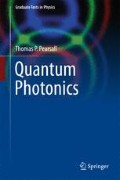Abstract
LASER is an acronym for Light Amplification by Stimulated Emission of Radiation. Laser action is a general principle of the behavior of light absorption and emission by matter. A laser is an amplifier with positive feedback. Amplification is generated by stimulated emission of photons, and positive feedback is achieved using mirrors. The physics of spontaneous and stimulated emission of photons is directly seen though quantization of the electromagnetic fields. The transition rate for stimulated emission depends on the number of photons already present in the electro-magnetic mode. Spontaneous emission can only be understood as a quantum reaction with the vacuum. Photons created by spontaneous emission act as seeds for subsequent stimulated optical transitions. Population inversion is needed to raise the stimulated emission rate above the rate of spontaneous emission. Optical gain will occur if the stimulated emission rate exceeds the stimulated absorption rate. Such a situation cannot occur in a two level system because the same two levels are responsible both for absorption and emission of photons. In a three or four level system, the equilibrium between absorption and emission is maintained, but the absorption takes place between one set of levels and the emission takes place between a different set. A critical parameter for laser performance is the threshold current density. The double-heterostructure laser concept is based on confinement of the optical mode and the recombination of electrons and holes to the same region of space. Application of quantum confinement has dramatically improved this design by separate optimization of the optical confinement region and the electron-hole recombination region. This results in a steep reduction in the threshold current and a gain factor that is independent of operating drive current.
Access this chapter
Tax calculation will be finalised at checkout
Purchases are for personal use only
References
G.P. Agrawal, N.K. Dutta, Long Wavelength Semiconductor Lasers (Van Nostrand Reinhold, New York, 1986). ISBN-13: 978-0442209957
P.K. Bhattacharya, Semiconductor Optoelectronic Devices (Prentice-Hall, Englewood Cliffs, 1994). ISBN 0-13-805748-6
H. C. Casey, Jr., M.B. Panish, Heterostructure Lasers (Academic Press, Orlando, 1978). ISBN 0-12-163101-X
S.L. Chuang, Physics of Optoelectronic Devices, 2nd edn. (Wiley, New York, 2010). ISBN 978-0-0470-23919-5
L.A. Coldren, S.W. Corzine, M.L. Mashanovitch, Diode Lasers and Photonic Integrated Circuits, 2nd edn. (Wiley, Hoboken, 2012). ISBN-13: 978-0470484128
E.O. Goebel, GaInAsP Alloy Semiconductors, ed by T.P. Pearsall (Wiley, Chichester, 1982)
R.N. Hall, G.E. Fenner, J.D. Kingsley, T.J. Soltys, R.O. Carlson, Phys Rev Lett 9, 366–369 (1962)
T.P. Pearsall, Photonics Essentials, 2nd edn. (New York McGraw-Hill, 2008). ISBN: 978-0-07-162935-5
K. Unterrainer, C. Kremser, E. Gornik, C.R. Pidgeon, YuL Ivanov, E.E. Haller, Tunable cyclotron-resonance laser in germanium. Phys Rev Lett 64, 2277–2280 (1990)
A.Yariv, Optical Electronics in Modern Communications (Oxford University Press, USA, 1996)
Author information
Authors and Affiliations
Corresponding author
Exercises
Exercises
-
1.
Laser action can occur when the stimulated emission rate exceeds the spontaneous emission rate; (see 7.37). What would happen if you reduced the spontaneous emission rate to zero? Would you have a threshold-less laser? Explain your answer.
-
2.
Calculate the ratio of the spontaneous to stimulated emission rates at thermal equilibrium at T = 300 K, for an electron transition of 0.2 eV (infrared) 4 eV (near UV)
-
3.
Estimate the threshold current density in A cm−2 of a GaAs-based laser with the following properties:
Emission wavelength = 850 nm
Linewidth of the gain spectrum = 1.5 × 1013 Hz
Internal losses = 30 cm−1
Index of refraction = 3.5
Cavity length = 400 μm
Thickness of the recombination region = 200 nm
-
4.
Compare threshold of GaN laser to GaAs laser. What can be changed?
Rights and permissions
Copyright information
© 2017 Springer International Publishing AG
About this chapter
Cite this chapter
Pearsall, T.P. (2017). Lasers. In: Quantum Photonics. Graduate Texts in Physics. Springer, Cham. https://doi.org/10.1007/978-3-319-55144-9_7
Download citation
DOI: https://doi.org/10.1007/978-3-319-55144-9_7
Published:
Publisher Name: Springer, Cham
Print ISBN: 978-3-319-55142-5
Online ISBN: 978-3-319-55144-9
eBook Packages: Physics and AstronomyPhysics and Astronomy (R0)

